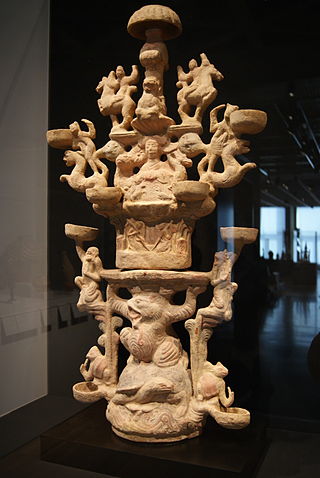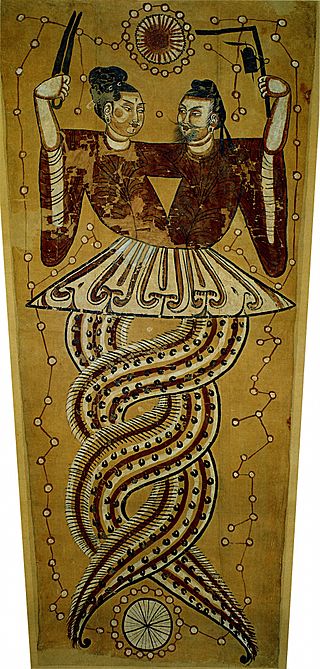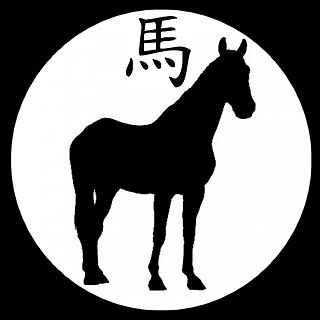Related Research Articles

Chinese mythology is mythology that has been passed down in oral form or recorded in literature throughout the area now known as Greater China. Chinese mythology encompasses a diverse array of myths derived from regional and cultural traditions. Populated with engaging narratives featuring extraordinary individuals and beings endowed with magical powers, these stories often unfold in fantastical mythological realms or historical epochs. Similar to numerous other mythologies, Chinese mythology has historically been regarded, at least partially, as a factual record of the past.
Hundun is both a "legendary faceless being" in Chinese mythology and the "primordial and central chaos" in Chinese cosmogony, comparable with the world egg.

The Chu ci, variously translated as Verses of Chu, Songs of Chu, or Elegies of Chu, is an ancient anthology of Chinese poetry including works traditionally attributed mainly to Qu Yuan and Song Yu from the Warring States period, and also a large number of works composed several centuries later, during the Han dynasty. The traditional version of the Chu ci contains 17 major sections, anthologized with its current contents by Wang Yi, a 2nd-century AD librarian who served under Emperor Shun of Han. The early Classical Chinese poetry is mainly known through the two anthologies the Chu ci and the Shi jing.

"Li Sao" is an ancient Chinese poem from the anthology Chuci traditionally attributed to Qu Yuan. Li Sao dates from the 3rd century BCE, during the Chinese Warring States period.
Mount Buzhou was an ancient Chinese mythological mountain which, according to old texts, lay to the northwest of the Kunlun Mountains, in a location today referred to as the Pamir Mountains. It is the mountain said to have supported the heavens, against which the Chinese water god Gonggong smashed his head in a fit of anger, requiring the goddess Nüwa to repair the sky. Nevertheless, once the spacer between the Earth and Sky was damaged, the land of China was permanently tilted to the southeast, causing all the rivers to flow in that same direction.

The Heavenly Questions or Questions to Heaven is a piece contained in the Classical Chinese poetry collection of Chu Ci, which is noted both in terms of poetry and as a source for information on the ancient culture of China, especially the area of the ancient state of Chu. Of all the poems attributed to Qu Yuan, "Tianwen" contains more myths than any of the other pieces which may be attributed to him; however, due to the formal structure of "Tianwen" as a series of questions, information regarding the myths alluded to appear more as a series of allusive fragments than as cohesively narrated stories.

The Kunlun or Kunlun Shan is a mountain or mountain range in Chinese mythology, an important symbol representing the axis mundi and divinity.

Snakes are an important motif in Chinese mythology. There are various myths, legends, and folk tales about snakes. Chinese mythology refers to these and other myths found in the historical geographic area(s) of China. These myths include Chinese and other languages, as transmitted by Han Chinese as well as other ethnic groups.

Horses are an important motif in Chinese mythology. There are many myths about horses or horse-like beings, including the pony. Chinese mythology refers to those myths found in the historical geographic area of China. This includes myths in Chinese and other languages, as transmitted by Han Chinese as well as other ethnic groups. There are various motifs of horses in Chinese mythology. In some cases the focus is on a horse or horses as the protagonist of the action, in other cases they appear in a supporting role, sometimes as the locomotive power propelling a chariot and its occupant(s). According to a cyclical Chinese calendar system, the time period of 31 January 2014 - 18 February 2015 falls under the category of the (yang) Wood Horse.

Hebo, also known as Bīngyí (冰夷), is the god of the Yellow River. The Yellow River is the main river of northern China, one of the world's major rivers and a river of great cultural importance in China. This is reflected in Chinese mythology by the tales surrounding the deity Hebo.

The Yellow River Map, Scheme, or Diagram, also known by its Chinese name as the Hetu, is an ancient Chinese diagram that appears in myths concerning the invention of writing by Cangjie and other culture heroes. It is usually paired with the Luoshu Square—named in reference to the Yellow River's Luo tributary—and used with the Luoshu in various contexts involving Chinese geomancy, numerology, philosophy, and early natural science.
The Flood Mythology of China, or Great Flood of China is a deluge theme which happened in China. Derk Bodde (1961) stated that "from all mythological themes in ancient Chinese, the earliest and so far most pervasive is about flood." The mythology also has shared characteristics with other Great Floods all over the world, although it also has unique characteristics or different focuses. Lu Yilu (2002) groups all versions of great flood into three themes: "the heroes controls the flood; "brother-sister marriage to repopulating the world"; and "the flood which is drowning the whole city along with its citizens".
The Eight Pillars also known as Eight Pillars of the Sky are a concept from Chinese mythology. Located in the eight cardinal directions, they are a group of eight mountains or pillars which have been thought to hold up the sky. They are symbolically important as types of axis mundi and cosmology. Their functions in mythology ranged from pillars which functioned to hold apart the Earth and the Sky, as ladders allowing travel between the two, and as the location of various paradises or wonderland with associated magical people, plants, and animals. The Eight Pillars are a central aspect to Chinese mythology, and also have been used extensively in poetic allusion. Some variations exist, such as only having four pillars.

The Weak River also known as the Weak Water or Ruoshui is an important feature in the mythical geography of Chinese literature, including novels and poetry over a course of over two millennia from the Warring States to early Han dynasty era poetry of the Chuci onward. The Weak River is one of the mythological rivers flowing near Kunlun, home of a Western Paradise. The Weak River flowed with "water" so lacking in specific gravity that even a feather would not float, thus being a protective barrier against the unworthy, who otherwise would profane the paradise on Kunlun, and perhaps even climb up to Heaven and disturb the deities and other inhabitants residing there. In the novel Journey to the West, the Weak Water River forms one of the obstacles the fictional version of the monk Xuanzang, the magic monkey Sun Wukong, and companions must cross over on their mission to fetch the Buddhist scriptures from India and return them to Tang China.
The Red River or Red Water is an important feature in the mythological geography of Chinese literature, including novels and poetry over a course of over two millennia from the Warring States to early Han dynasty era poetry of the Chuci onward. The Red River is one of the mythological rivers said to flow from Kunlun, a mythological land, with mountainous features. Translations into English include "Scarlet River".

The Moving Sands, also known as the Flowing Sands, is an important feature in the mythological geography of Chinese literature, including novels and poetry over a course of over two millennia from the Warring States to early Han dynasty era poetry of the Chuci onward to the present. In his poem "Li Sao", author Qu Yuan describes an aerial crossing of the Moving Sands on a shamanic spiritual Journey to Kunlun. "Moving Sands forms one of the obstacles the fictional version of the monk Xuanzang and companions must cross over on their mission to fetch the Buddhist scriptures from India and return them to Tang China. In this story, Xuanzang recruits the former sand demon and eater-of-humans Sha Wujing who is living in Moving Sands as his third disciple. Sometimes the Moving Sands seem to depict drifting dunes or desert, sometimes a sand or quicksand-like river, in which case, in Chinese, it would be (Liúshā-hé.

Birds in Chinese mythology and legend are of numerous types and very important in this regard. Some of them are obviously based on real birds, other ones obviously not, and some in-between. The crane is an example of a real type of bird with mythological enhancements. Cranes are linked with immortality, and may be transformed xian immortals, or ferry an immortal upon their back. The Vermilion Bird is iconic of the south. Sometimes confused with the Fenghuang, the Vermilion Bird of the south is associated with fire. The Peng was a gigantic bird phase of the gigantic Kun fish. The Jingwei is a mythical bird which tries to fill up the ocean with twigs and pebbles symbolizing indefatigable determination. The Qingniao was the messenger or servant of Xi Wangmu.

Chinese mythological geography refers to the related mythological concepts of geography and cosmology, in the context of the geographic area now known as "China", which was typically conceived of as the center of the universe. The "Middle Kingdom" thus served as a reference point for a geography sometimes real and sometimes mythological, including lands and seas surrounding the Middle Land, with mountain peaks and sky above, with sacred grottoes and an underworld below, and even sometimes with some very abstract other worlds.

Legendary weapons, arms, and armor are important motifs in Chinese mythology as well as Chinese legend, cultural symbology, and fiction. Weapons featured in Chinese mythology, legend, cultural symbology, and fiction include Guanyu's pole weapon. This non-factually documented weapon has been known as the Green Dragon Crescent Blade. Other weapons from Chinese mythology, legend, cultural symbology, and fiction include the shield and battleax of the defiant dancer Xingtian, Yi's bow and arrows, given him by Di Jun, and the many weapons and armor of Chiyou, who is associated with the elemental power of metal. Chinese mythology, legend, cultural symbology, and fiction features the use of elemental weapons such as ones evoking the powers of wind and rain to influence battle.
References
- Barrett, T. H. 2008. The Woman Who Discovered Printing. New Haven: Yale University Press. ISBN 978-0-300-12728-7
- Christie, Anthony (1968). Chinese Mythology. Feltham: Hamlyn Publishing. ISBN 0600006379
- Ferguson, John C. 1928. "China" in Volume VIII of Mythology of All Races. Archaeological Institute of America. <archive.org>
- Hawkes, David, translator and introduction (2011 [1985]). Qu Yuan et al., The Songs of the South: An Ancient Chinese Anthology of Poems by Qu Yuan and Other Poets. London: Penguin Books. ISBN 978-0-14-044375-2
- Latourette, Kenneth Scott The Chinese: Their History and Culture (Third Edition, Revised), 1947. New York: Macmillan.
- Legge, James, translator and "Introduction". The I Ching: The Book of Changes Second Edition. New York: Dover 1963 (1899). Library of Congress 63-19508
- Paludan, Ann (1998). Chronicle of the Chinese Emperors: The Reign-by-Reign Record of the Rulers of Imperial China. New York, New York: Thames and Hudson. ISBN 0-500-05090-2
- Paper, Jordan D. (1995). The Spirits are Drunk: Comparative Approaches to Chinese Religion. Albany, New York: State University of New York Press. ISBN 0-7914-2315-8.
- Schafer, Edward H. (1963) The Golden Peaches of Samarkand. Berkeley: University of California Press.
- Sheppard, Odell. 1930. The Lore of the Unicorn -- Myths and Legends. London: Random House UK. ISBN 0 09 185135 1 and ISBN 1-85958-489-6 (both claimed on book)
- Siu, R. G. H. 1968. The Man of Many Qualities: A Legacy of the I Ching, "Preface" and "Introduction". Cambridge: Michigan Institute of Technology Press. LoCccn 68-18242.
- Strassberg, Richard E., editor, translator, and comments. 2002 [2018]. A Chinese Bestiary: Strange Creatures from the GUIDEWAYS THROUGH MOUNTAINS AND SEAS. Berkeley and Los Angeles: University of California Press. ISBN 978-0-520-29851-4
- Werner, E.T.C. (1922). Myths and Legends of China. New York: George G. Harrap & Co. Ltd.
- Werner, E. T. C. (1994 [1922]). Myths and Legends of China. New York: Dover Publications. ISBN 0-486-28092-6
- Wu, K. C. (1982). The Chinese Heritage. New York: Crown Publishers. ISBN 0-517-54475X.
- Yang, Lihui and Deming An, with Jessica Anderson Turner (2005). Handbook of Chinese Mythology. New York: Oxford University Press. ISBN 978-0-19-533263-6